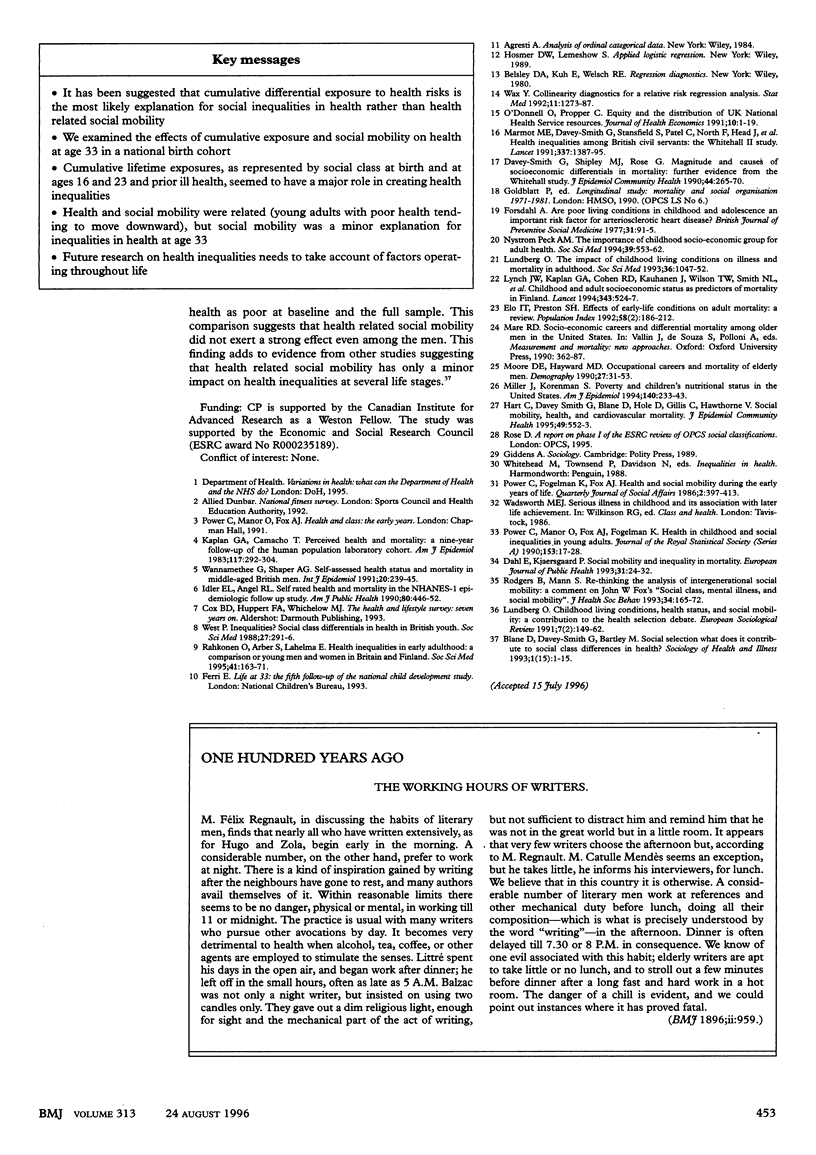Abstract
OBJECTIVE: To investigate explanations for social inequalities in health with respect to health related social mobility and cumulative socioeconomic circumstances over the first three decades of life. DESIGN: Longitudinal follow up. SETTING: Great Britain. SUBJECTS: Data from the 1958 birth cohort study (all children born in England, Wales, and Scotland during 3-9 March 1958) were used, from the original birth survey and from sweeps at 16, 23, and 33 years. MAIN OUTCOME MEASURES: Subjects' own ratings of their health; social differences in self rated health at age 33. RESULTS: Social mobility varied by health status, with those reporting poor health at age 23 having higher odds of downward mobility than of staying in same social class. Men with poor health were also less likely to be upwardly mobile. Prevalence of poor health at age 33 increased with decreasing social class: from 8.5% in classes I and II to 17.7% in classes IV and V among men, and from 9.4% to 18.8% among women. These social differences remained significant after adjustment for effects of social mobility. Health inequalities attenuated when adjusted for social class at birth, at age 16, or at 23 or for self rated health at age 23. When adjusted for all these variables simultaneously, social differences in self rated health at age 33 were substantially reduced and no longer significant. CONCLUSIONS: Lifetime socioeconomic circumstances accounted for inequalities in self reported health at age 33, while social mobility did not have a major effect on health inequalities.
Full text
PDF




Selected References
These references are in PubMed. This may not be the complete list of references from this article.
- Elo I. T., Preston S. H. Effects of early-life conditions on adult mortality: a review. Popul Index. 1992 Summer;58(2):186–212. [PubMed] [Google Scholar]
- Idler E. L., Angel R. J. Self-rated health and mortality in the NHANES-I Epidemiologic Follow-up Study. Am J Public Health. 1990 Apr;80(4):446–452. doi: 10.2105/ajph.80.4.446. [DOI] [PMC free article] [PubMed] [Google Scholar]
- Kaplan G. A., Camacho T. Perceived health and mortality: a nine-year follow-up of the human population laboratory cohort. Am J Epidemiol. 1983 Mar;117(3):292–304. doi: 10.1093/oxfordjournals.aje.a113541. [DOI] [PubMed] [Google Scholar]
- Lundberg O. The impact of childhood living conditions on illness and mortality in adulthood. Soc Sci Med. 1993 Apr;36(8):1047–1052. doi: 10.1016/0277-9536(93)90122-k. [DOI] [PubMed] [Google Scholar]
- Lynch J. W., Kaplan G. A., Cohen R. D., Kauhanen J., Wilson T. W., Smith N. L., Salonen J. T. Childhood and adult socioeconomic status as predictors of mortality in Finland. Lancet. 1994 Feb 26;343(8896):524–527. doi: 10.1016/s0140-6736(94)91468-0. [DOI] [PubMed] [Google Scholar]
- Marmot M. G., Smith G. D., Stansfeld S., Patel C., North F., Head J., White I., Brunner E., Feeney A. Health inequalities among British civil servants: the Whitehall II study. Lancet. 1991 Jun 8;337(8754):1387–1393. doi: 10.1016/0140-6736(91)93068-k. [DOI] [PubMed] [Google Scholar]
- Miller J. E., Korenman S. Poverty and children's nutritional status in the United States. Am J Epidemiol. 1994 Aug 1;140(3):233–243. doi: 10.1093/oxfordjournals.aje.a117242. [DOI] [PubMed] [Google Scholar]
- Moore D. E., Hayward M. D. Occupational careers and mortality of elderly men. Demography. 1990 Feb;27(1):31–53. [PubMed] [Google Scholar]
- O'Donnell O., Propper C. Equity and the distribution of UK National Health Service resources. J Health Econ. 1991 May;10(1):1–19. doi: 10.1016/0167-6296(91)90014-e. [DOI] [PubMed] [Google Scholar]
- Peck M. N. The importance of childhood socio-economic group for adult health. Soc Sci Med. 1994 Aug;39(4):553–562. doi: 10.1016/0277-9536(94)90098-1. [DOI] [PubMed] [Google Scholar]
- Rahkonen O., Arber S., Lahelma E. Health inequalities in early adulthood: a comparison of young men and women in Britain and Finland. Soc Sci Med. 1995 Jul;41(2):163–171. doi: 10.1016/0277-9536(94)00320-s. [DOI] [PubMed] [Google Scholar]
- Rodgers B., Mann S. L. Re-thinking the analysis of intergenerational social mobility: a comment on John W. Fox's "Social class, mental illness, and social mobility". J Health Soc Behav. 1993 Jun;34(2):165–177. [PubMed] [Google Scholar]
- Smith G. D., Shipley M. J., Rose G. Magnitude and causes of socioeconomic differentials in mortality: further evidence from the Whitehall Study. J Epidemiol Community Health. 1990 Dec;44(4):265–270. doi: 10.1136/jech.44.4.265. [DOI] [PMC free article] [PubMed] [Google Scholar]
- Wannamethee G., Shaper A. G. Self-assessment of health status and mortality in middle-aged British men. Int J Epidemiol. 1991 Mar;20(1):239–245. doi: 10.1093/ije/20.1.239. [DOI] [PubMed] [Google Scholar]
- Wax Y. Collinearity diagnosis for a relative risk regression analysis: an application to assessment of diet-cancer relationship in epidemiological studies. Stat Med. 1992 Jul;11(10):1273–1287. doi: 10.1002/sim.4780111003. [DOI] [PubMed] [Google Scholar]
- West P. Inequalities? Social class differentials in health in British youth. Soc Sci Med. 1988;27(4):291–296. doi: 10.1016/0277-9536(88)90262-6. [DOI] [PubMed] [Google Scholar]


